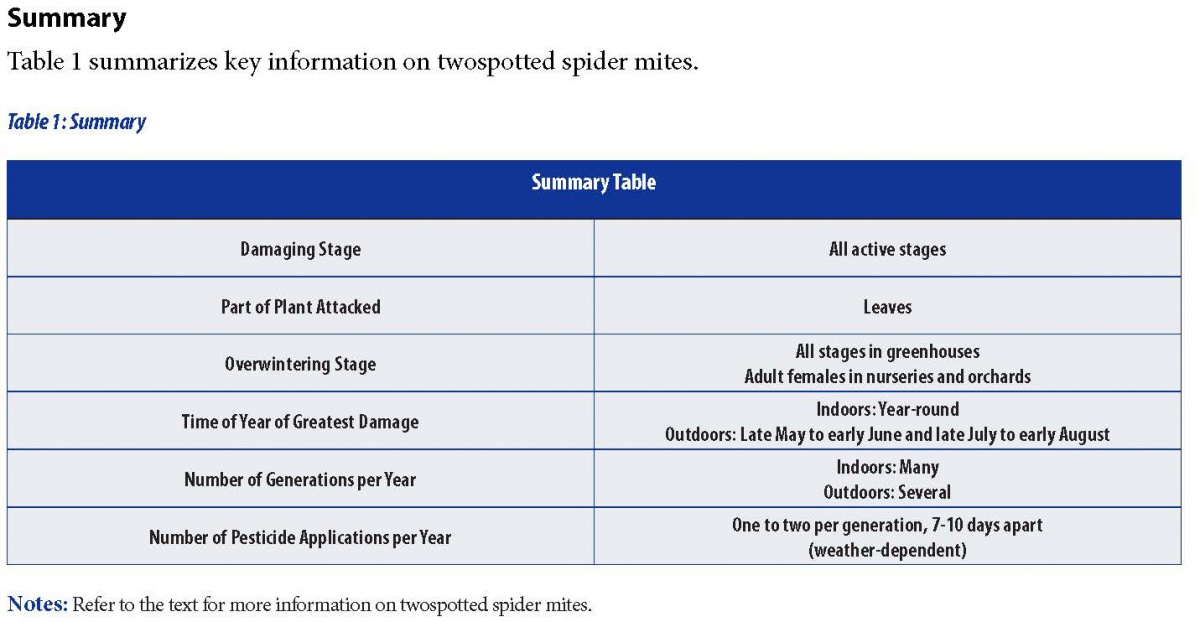Several species of spider mites invade field, garden, greenhouse, nursery, and ornamental plants. The most troublesome of these spider mites is the twospotted spider mite, Tetranychus urticae. This mite removes sap from leaf tissues, leaving leaves speckled. When severely infested, the entire plant may die.

and adults). Credit: Whitney Cranshaw, Colorado
State University, Bugwood.org
Description
The eggs of twospotted spider mites are spherical, clear to pale green, and shiny. They are usually found on the underside of leaves where adults feed. They are attached to leaves in webbing spun by adults.
The first instar is a six-legged stage called a larva and is similar in shape and color to the adult. The adult is an eight-legged mite, ranging in color from green to brown. The male is smaller than the female, and has a narrower, pointed abdomen. Both sexes have sparse spines and two dark pigmented areas on their back. These pigmented areas are food particles which can be seen through the body wall. The twospotted spider mite is quite small with the adult female averaging 1/64" in length.
Life Cycle
This non-insect pest goes through four stages of development: egg, larva, nymph, and adult. After being deposited, an egg hatch in 3-19 days, depending upon temperatures. After hatching, the 6-legged larva immediately starts feeding on leaves. Later, it changes into an 8-legged nymph stage, and then into an adult in about 19 days. It feeds continually during this time.
There are several continuous generations per year in greenhouses. In New Hampshire, this mite overwinters outdoors as an adult female. Spider mites are often a severe problem in hot, dry weather.

plant (look for the miniature white dots). Credit:
MarieEve Jacques.
Management
IPM Strategies:
- Sanitation - Keep the greenhouse clean and weed free. This will provide fewer opportunities for pest mites to get established.
- Monitoring - Visually inspect plant material before allowing it to enter your greenhouse. Regular inspections of your plants will determine mite numbers and patterns of infestation, guiding how to control them. Removing infested plants or plant parts may suffice if it only a few plants are infested. Otherwise pesticide applications may be needed.
- Biological Control - In greenhouses or other enclosed spaces, growers can purchase and introduce predatory mites to control the plant-feeding mites. Begin introductions before high pest mite populations develop.
- Chemical Control - Miticides usually only control adults and nymphs, not eggs. A second spray should be considered in 7-10 days after the first to control recently hatched nymphs. Thorough spray coverage is necessary. Apply only to plants and site listed on the label. Selecting reduced risk miticides may be necessary.
Consult your county Extension Field Specialist for specific recommendations.

vulgaris): stippling injuries to leaves. Credit: Whitney Cranshaw,
Colorado State University, Bugwood.org.

Stop! Read the label on every pesticide container each time before using the material. Pesticides must be applied only as directed on the label to be in compliance with the law. All pesticides listed in this publication are contingent upon continued registration. Contact the Division of Pesticide Control at (603) 271-3550 to check registration status. Dispose of empty containers safely, according to New Hampshire regulations.
Download the resource for the complete factsheet.
